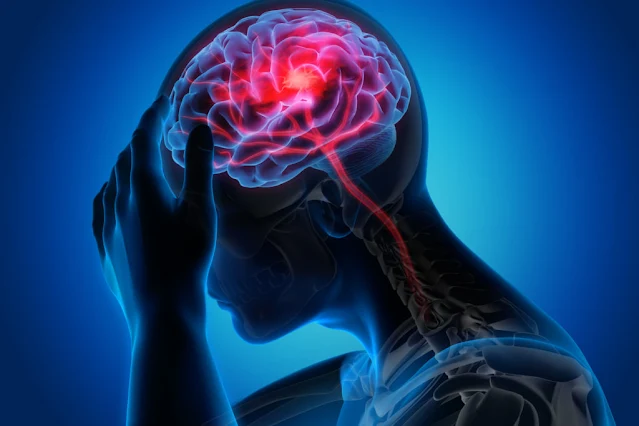INTRODUCTION: A cerebrovascular accident (CVA), an ischemic stroke or “brain attack,” is a sudden loss of brain function resulting from a disruption of the blood supply to a part of the brain. Strokes are usually hemorrhagic (15%) or ischemic (85%). Ischemic strokes are categorized according to their cause: large artery thrombotic strokes (20%), small penetrating artery thrombotic strokes (25%), cardiogenic embolic strokes (20%), cryptogenic strokes (30%), and other (5%). Cryptogenic strokes have no known cause, and other strokes result from causes such as illicit drug use, coagulopathies, migraine, and spontaneous dissection of the carotid or vertebral arteries. The result is an interruption in the blood supply to the brain, causing temporary or permanent loss of movement, thought, memory, speech, or sensation.
RISK FACTORS: Non modifiable include; Advanced age especially older than 55 years, Gender; the Male are more volunerable, Race; very common for African American. Modifiable; Hypertension, Atrial fibrillation, Hyperlipidemia, Obesity, Smoking, Diabetes Asymptomatic carotid stenosis and valvular heart disease such as, endocarditis, prosthetic heart valves, and finally Periodontal disease.
CLINICAL MANIFESTATIONS: General signs and symptoms include numbness or weakness of face, arm, or leg; confusion or change in mental status; trouble speaking or understanding speech; visual disturbances; loss of balance, dizziness, difficulty walking; or sudden severe headache. Motor Loss; Hemiplegia, hemiparesis. Flaccid paralysis and loss of or decrease in the deep tendon reflexes followed by reappearance of deep reflexes and abnormally increased muscle tone. Communication Loss; Dysarthria commonly known as difficulty in speaking, Dysphasia (impaired speech) or aphasia (loss of speech). Apraxia (inability to perform a previously learned action). Perceptual Disturbances and Sensory Loss. Visual-perceptual dysfunctions (homonymous hemianopia [loss of half of the visual field]). Disturbances in visual-spatial relations (perceiving the relation of two or more objects in spatial areas), frequently seen in patients with right hemispheric damage. Sensory losses: slight impairment of touch or more severe with loss of proprioception; difficulty in interrupting visual, tactile, and auditory stimuli. Impaired Cognitive and Psychological Effects. Frontal lobe damage: Learning capacity, memory, or other higher cortical intellectual functions may be impaired. Such dysfunction may be reflected in a limited attention span, difficulties in comprehension, forgetfulness, and lack of motivation. Depression, other psychological problems: emotional lability, hostility, frustration, resentment, and lack of cooperation.
ASSESSMENT AND DIAGNOSTIC METHODS: History and complete physical and neurologic examination. Noncontrast CT scan. 12-lead ECG and carotid ultrasound. CT angiography or MRI and angiography. Transcranial Doppler flow studies. Transthoracic or transesophageal echocardiography. Xenon-enhanced CT scan. Single photon emission CT (SPECT) scan.
PREVENTION: Help patients alter risk factors for stroke; encourage patient to quit smoking, maintain a healthy weight, follow a healthy diet (including modest alcohol consumption), and exercise daily. Administer anticoagulant agents as prescribed such as, low-dose aspirin therapy.
MEDICAL MANAGEMENT: Recombinant tissue plasminogen activator (t-PA), unless contraindicated; monitor for bleeding. Anticoagulation therapy. Management of increased intracranial pressure (ICP): osmotic diuretics, maintain PaCO2 at 30 to 35 mm Hg, position to avoid hypoxia (elevate the head of bed to promote venous drainage and to lower increased ICP). Possible hemicraniectomy for increased ICP from brain edema in a very large stroke. Intubation with an endotracheal tube to establish a patent airway, if necessary. Continuous hemodynamic monitoring. Neurologic assessment to determine if the stroke is evolving and if other acute complications are developing.
MANAGEMENT OF COMPLICATIONS: Decreased cerebral blood flow: Pulmonary care, maintenance of a patent airway, and administration of supplemental oxygen as needed. Monitor for UTIs, cardiac dysrhythmias, and complications of immobility.
RELATED;
1. SHOCK












2 comments:
Thank you so much blog admin for this great opportunity to show my gratitude to Dr Itua herbal center who cure my lyme disease completely within 3 three weeks of usage, I was first nervous about the whole stuff until I finally drank his herbal medicine then get tested and see that he real herbal doctor with great herbs knowledge.Dr Itua herbal medicine cures all sorts of illness and disease such as hiv,herpes,cancer,hepatitis,diabetes,lyme and other bacteria infections as well.You can contact dr Itua on email; drituaherbalcenter@gmail.com or visit his website for more information.Dr Itua did not know that I'm doing this but I think the only way for me to show my gratitude is to heal the world with his herbal knowledge through his goodness.
Thank you once again blog admin.
You are welcome Mr. Asahiko. I will definitely have to contact you via email.
Post a Comment